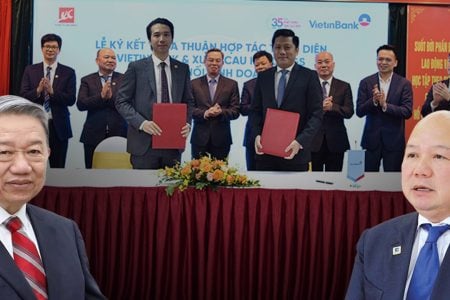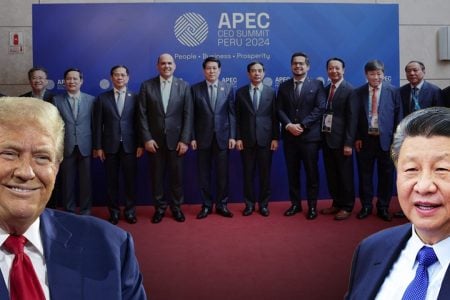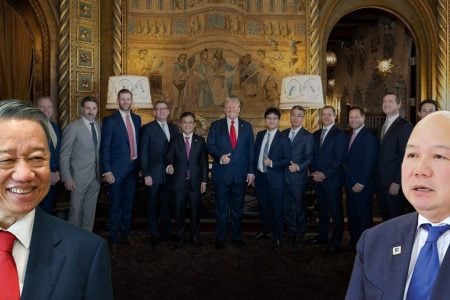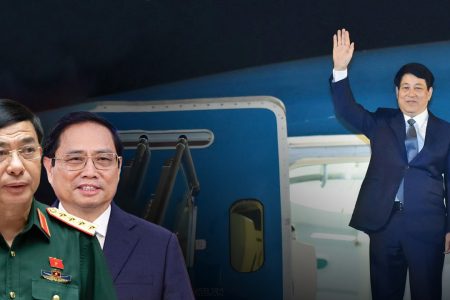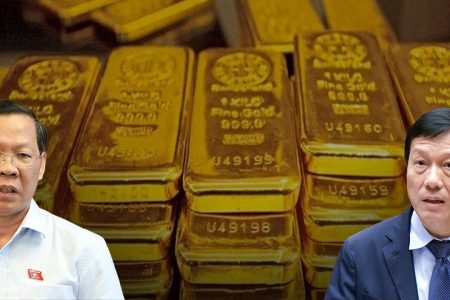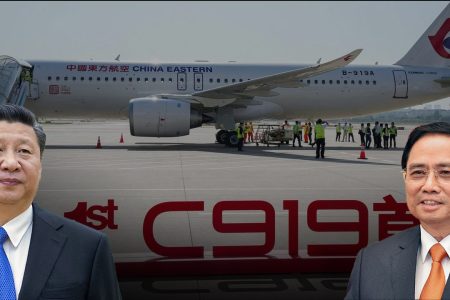China’s Ministry of Foreign Affairs said on April 21 that it had „strictly dealt with“ in response to what it called „Vietnam illegally claiming sovereignty in the South China Sea [East Sea in Vietnamese],“ according to Reuters and The Beijing News.
It is reported that Geng Shuang, a spokesman for China’s Ministry of Foreign Affairs, said at a daily press conference that since the end of March, Vietnam’s Permanent Mission to the United Nations had sent a number of diplomatic notes to the Secretary-General of the United Nations, „repeatedly declaring illegal sovereignty“ in the South China Sea, as well as „trying to deny“ China’s sovereignty and rights in the waters.
„China resolutely opposes it and has strictly dealt with Vietnam,“ Geng Shuang declared, still according to Reuters and The Beijing News.
A Chinese Foreign Ministry spokesperson continued to emphasize that any country that tries to deny China’s sovereignty in the South China Sea in any way is „invalid“ and „will certainly fail,” said Reuters and The Beijing News.
„China will take all necessary measures to firmly defend its sovereignty, rights and interests in the South China Sea,“ Geng Shuang said.
According to VOA’s observation, until this news was posted, the Vietnamese side did not give any official response to the latest statement of the Chinese Foreign Ministry spokesman.
Earlier, as VOA reported, Vietnam protested China’s expansion efforts in disputed waters, including sending a claim to the UN.
Some analysts and observers commented to VOA that the phrase „all necessary measures“ in the April 21 statement of the Chinese side was very noticeable because it implied threats, as well as not excluded except for China coming to use military force.
This is the second time in just four days, China hinted at the use of force, according to law master Hoang Viet, a longtime researcher on the South China Sea.
He mentioned China’s April 17 note sent to the UN Secretary General to oppose Vietnam, which states: „China resolutely insists that Vietnam withdraw all crews and facilities from the islands and rocks that the country has invaded and occupied illegally „in the Truong Sa (Spratlys).
Researcher Hoang Viet commented to VOA about the continuous signals from China in the past few days: “It is very likely that at this time, China may take stronger actions in the South China Sea.”
Vietnam’s policy in the current period, according to Mr. Hoang Viet, is „to hold the ground“ in combination with diplomatic and peaceful measures. He added to VOA:
“Vietnam is occupying and controlling all 21 structures in Truong Sa, as well as many DK rigs, exclusive economic zone, continental shelf of Vietnam, Vietnam must resolutely hold on. If not sustained, it can be very big threat. Vietnam needs to continue to send diplomatic notes, and Vietnam must lobby directly related countries such as Malaysia and the Philippines to send diplomatic notes for this case.”
On a broader scale, Mr. Viet, a member of the Maritime Law Research Board, under the Vietnam Bar Federation, proposed that Vietnam take advantage of the current position of the president of the ASEAN countries (ASEAN) to work in joint with the members and make a joint statement. In addition, Vietnam needs to call for the voice of other countries in the international community, according to Mr. Viet.
The fourth measure of the countermeasures is that Vietnam sues China for international court, if necessary, Mr. Viet told VOA.
In the context of an increasingly tense situation, this researcher warns that Vietnam needs to remain calm against provocative acts, or „below the war threshold,“ of China.

“There are analyzes that China will besiege and block Vietnam’s supply routes to islands in the Spratlys or DKK regions. These are things that Vietnam must consider, how to protect itself without being trapped by China in the first shooting or provoking China, so that China can create excuses.“
Regarding the cause of China becoming more aggressive in the current period, Viet told VOA that China’s supreme leader, Xi Jinping, who may have been facing internal political challenges in the context of the economic downturn last year due to trade war with the United States, wants to turn his attention outside, especially to the East Sea.
Besides, according to Viet, the international situation is also favorable for China to pursue its goals in the South China Sea, when countries are busy dealing with the Covid-19 pandemic, in which, the US Navy is temporarily weakening because two aircraft carriers with many infected sailors have to cease operations.
China names dozens of islands and entities in the East Sea
Just on April 19, the Chinese People’s Ministry announced a „standard title“ for 25 islands, reefs and 55 undersea geographical features in the South China Sea.
The majority of these are located in the Hoang Sa (Paracel and the Truong Sa (Spratlys).
China also announces the longitude and latitude of islands, rocks and features.
Vietnam said in these entities there are shoals located deep within its exclusive economic zone, which is less than 60 nautical miles from the Vietnamese coast or about 50 nautical miles from the Vietnamese baseline.
Just one day before, on April 18, Chinese media reported that China had decided to establish the so-called „Xisha District“ and „Nansha District“ of „Sansha City,“ taking the Cross Rock reed China seized Vietnam as the headquarters (the government agency) managing these two districts.
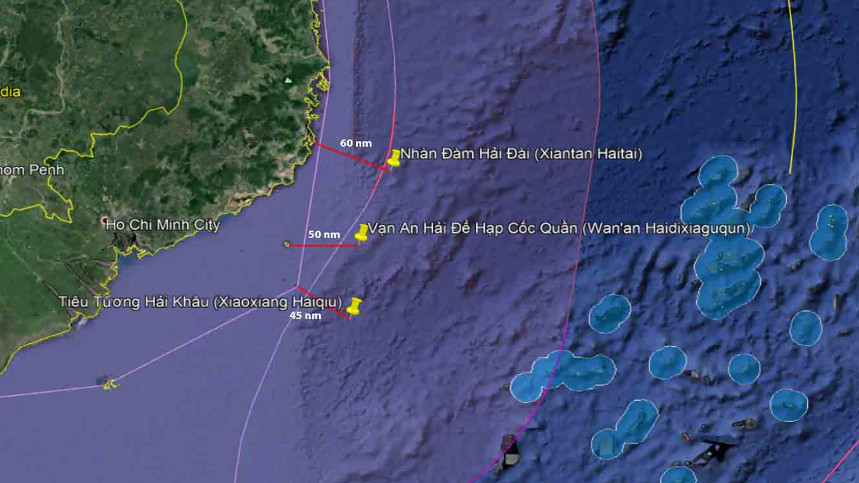
This is the „administrative unit“ that China established in 2012 to manage „Xisha, Zhongsha and Nansha.“
On April 19, Vietnamese Foreign Ministry’s Spokesman Le Thi Thu Hang spoke out against China announcing the establishment of „Xisha and Nansha County.”
„Vietnam has repeatedly affirmed that Vietnam has sufficient historical evidence and legal grounds to assert sovereignty over the Hoang Sa and the Truong Sa.
Vietnam’s consistent stance is strongly opposed to the establishment of the so-called „Tam Sa/Sansha city“ and related acts because of a serious violation of Vietnam’s sovereignty, invalid and unreasonable, not conducive to friendly relations between nations and complicates the situation in the East Sea, the region and the world,“ Ms Hang said.
On April 20, from Beijing, Spokesman Geng Shuang responded that the country’s establishment of administrative units was „sovereign.“
„China resolutely opposes Vietnam’s words and actions that harm China’s sovereignty and interests in Nanhai,“ said Geng Shuang.
Back to the latest press conference on April 21, state-run newspaper CGTN quoted Mr. Geng Shuang: „The attempt of any country to violate China’s sovereignty and interests in the South China Sea and to claim illegal sovereignty will be in vain.“
In an article on RFA Vietnamese titled „What must Vietnam do to counter Chinese threats in the South China Sea?“ Hoai Dong gives some analysis on China’s new developments and necessary actions of Vietnam.
“Currently, there are several reasons why China is increasing its aggressive actions in the South China Sea.
Firstly, the PLA is strengthening its power, including the commissioning of two aircraft carriers (Liaoning and Shandong) and conducting operations closer to the Taiwan and the Filipino Straits, threatening Indonesia as well as Japan in the East China Sea.
It seems that China is expanding the establishment of the periphery of the „nine-dash line“, which now includes non-disputed areas such as Vietnam’s Vanguard Bank and Indonesia’s Natuna Sea area.
China is also sending ships to the East China Sea, implying that, in the context of the COVID-19 pandemic, such actions will help distract international attention and avoid allegations around the world about Beijing’s lack of global responsibility.
Second, the COVID-19 pandemic raises serious doubts about China’s commitment as a member state of the UN Security Council and its lack of transparency in its declarations about the pandemics, including casualties.
The South China Sea and North Korea’s missile tests give China an excuse to distract attention and increase nationalism in China, especially as President Xi Jinping is facing great dissatisfaction in the country.
What does the world need to do?
In addition to discussing, the international community needs to issue a statement that strongly criticizes Chinese behavior. On the part of regional countries and dialogue partners, they need to issue a unified statement that harshly criticizes China’s efforts to disrupt the regional order in the South China Sea. The „Quad“ countries including the US, Japan, Australia and India must conduct joint maritime surveillance activities regularly and even a confrontation with China will be a big lesson. help calm the sea.”
So what does Vietnam have to do to counter China’s threat in the South China Sea? Hai Dong’s author raised the problem.
“An Indian expert said that, until now, Vietnam must understand that global practices and dynamics have changed over time and identifying the US as a long-term enemy will not be beneficial to the benefits of Hanoi. Vietnam needs to sign a security agreement and a strategic partnership with the US which may be similar to the Indo-Japan global strategic partnership model and joint statement of security cooperation. The visit of the USS Roosevelt aircraft carrier of the US is not welcome in the Chinese strategic community, and Vietnam must actively allow ships of partner countries (except China) to visit its ports.
In addition, Vietnam needs to include the South China Sea issue into the agenda of the ASEAN Defense Ministers Meeting (ADMM +) by the end of this year, and all parties need to look for an appropriate binding Code of Conduct.
As the chairman of ASEAN, Vietnam needs to take a 5-step approach to solving the problem.
First, institutionalize a high power committee to promote and build consensus on the draft COC in ASEAN on a priority basis. Former prime ministers can join this committee to gain political acceptance and to build trust among sovereign states in the South China Sea.
Second, Vietnam must implement tripartite initiatives with dialogue partners and other sovereign claimants to conduct hydrographic surveys and mapping the ocean floor. The ASEAN dialogue partners (except for China) are indirectly affected by China’s tactics.
Third, Vietnam must create a Standard operating procedure (SOP) among ASEAN countries and issue a statement to maintain the status quo.
Fourthly, the need for a friendly and cooperative treaty on the South Chia Sea. It is possible to name this agreement „The zone of peace, freedom and innocent passage.“ The agreement should be signed by all dialogue partners and on the basis of ensuring freedom of navigation in this maritime area.
Fifth, Vietnam must call on the international community to prioritize the settlement of disputes in the South China Sea, because this is of utmost importance to maritime security and promote trade in the region,“ Hoai Dong concludes.
And Vietnam, after having clearly seen the face and intrigue of annexing the South China Sea, needs to have a decisive attitude and join the Liberal Democratic countries of the world to ally with the US and Europe and together protect the freedom of navigation, freedom of aviation and sovereignty of the country.
Thu Thuy from Hochiminh city – Thoibao.de (Translated)









